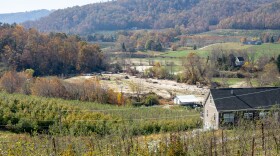Boardwalks snake outward from the visitor center through a cypress forest that borders Lake Mattamuskeet. Where the forest opens, 50 snowy egrets congregate in the canopy. A blue heron squawks above the muddy waters and cypress knees, which protrude like stalagmites from the mires below.
As beautiful as these wetlands are, they belong to an ecosystem under siege.
Kevin Dockendorf is a fisheries biologist for the North Carolina Wildlife Resources Commission. He’s standing on a walkway overlooking Outfall Canal’s tidal gates. These gates separate the brackish waters of the Pamlico Sound from the lake’s fresh water.
Dockendorf lowers a Secchi disk, a black and white disk attached to a measuring rope, into the water. The white of the disk disappears four inches below the surface.
“In clear systems,” Dockendorf says, “especially a shallow system, we would want to see two or three feet of transparency, because that's how far the sun is going to get down effectively.”

The average depth of Lake Mattamuskeet is 1.5 feet. On the lake side of the tidal gate, a two-foot gar swims through the sediment and algae. The dissolved oxygen at this gate is 0.16 milligrams per liter, which is too low for carp or bass. But gar and bowfin breathe with a “prehistoric lung” that allows them to gulp air from above the surface. Behind the gar, a grimy wake forms in a long triangle from the fish’s tail.
Alyson Flynn, an advocate with the North Carolina Coastal Federation, led the September public meeting to discuss the Lake Mattamuskeet Watershed Restoration plan.
“In 2016, the lake was put on the state's 303 D list,” Flynn said. “The reason it was put on the list was because the chlorophyll ‘a’ and pH levels of the lake were exceedingly high.”
For many species, these conditions were a death sentence. In 2017, refuge biologists recorded that all of the underwater grasses, often called SAV or submerged aquatic vegetation, had disappeared from the lake. Without these grasses, water clarity became much worse. Fish also lost vital shelter and nurseries, and toxic cyanobacteria, or blue-green algae, could more easily dominate the lake.

And the culprit for all this devastation?
“When common carp get into a system — especially a shallow water system like Mattamuskeet — they're able to dominate,” Dockendorf said. “SAV and carp do not mix, but carp and algae get along OK.”
The carp stir up the ground like a tiller. This action kicks sediment into the water column, which makes the water murkier. Now, sunlight can’t reach the underwater plants, and predators that rely on eyesight to hunt, like the bluegill, can’t see the carp eggs.
So, the challenge is turning off a 4 million pound tiller in a 40,000-acre lake. At least, that was the biomass estimate prior to the installation of carp barriers in March 2021.
The U.S. Fish and Wildlife Service and NC Wildlife Resources Commission have already taken actions to mitigate the carp problem. Commission biologists released bluegill, which eat carp eggs, near carp spawning zones. Refuge staff installed metal carp barriers in the canals. The barrier’s two-inch bars prevent adult carp from sneaking into the lake to breed.
“Back in the 1940s and 1950s, the lake was going through a somewhat similar situation where refuge management saw a decline in submerged aquatic vegetation." says Wendy Stanton, the acting refuge manager at Pocosin Lakes National Wildlife Refuge. “They also saw an abundant population of invasive common carp in the lake. So, they did a massive removal of common carp back in the 40s and 50s. They immediately saw an improvement in water clarity.”

Stanton said she would like to see 25 pounds per acre of carp or less in the lake. Even though the carp barriers have reduced the total carp, millions of pounds of fish still need to go.
It prompts the question: What do you do with all that carp?
“Well, we have all of this biomass of fish,” Dockendorf said. “We have all of this protein out there. Common carp were brought to the United States to feed the people.”
Although carp have not had their culinary moment in the United States yet, they have other uses. Carp can serve as ingredients for pet food or donations to osprey rehabilitation centers.
Although carp might be one of the primary drivers of the water quality issues in the lake, the Mattamuskeet Watershed Restoration Plan also tackles issues of hydrology, or the way water flows through the lake.
Michael Cahoon is a local farmer. He was representing the agricultural community in Hyde County at the public meeting in September.
“A lot of the farmland that I farm drains into Lake Mattamuskeet. [The farmland] has as been draining into it for years," Cahoon said. “The lake does have a problem that we want to solve. I’m on the side of the fence that [believes the lake] needs to be cleaned and maintained, as it was in the past.”
In 1934, a court settled a case between several parties involved in managing the lake. The resulting document guaranteed property owners continued access to the lake for drainage without cost.
“If you have a big storm like we've had in the past, where you got as much as 20 inches of water, the pumps may not be able to take care of all that water," Cahoon said.
Climate experts predict that these big storms will become more frequent with climate change. For some landowners, active management means dredging the canals to keep them clear. But the stakeholder group is considering other projects as well. Daniel Brinn, the Hyde County water and flood control coordinator, represents the interests of the farmers, hunters, and residents who rely on the lake for tourism, food, and other needs.
One project involves constructing a wetland on a neighboring landowner’s property.
“That wetland will take up sediment and nutrients from that water before it is discharged or enters another water body,” said Brinn.
Improving water flow in the lake and removing carp will both restore water quality to the lake and promote the growth of underwater grasses.
The U.S. Fish and Wildlife Service plans to open bidding for carp removal contracts and hopes bidding will open prior to the next carp spawning season in the spring of 2023.
For more information about the Lake Mattamuskeet Restoration Plan:






